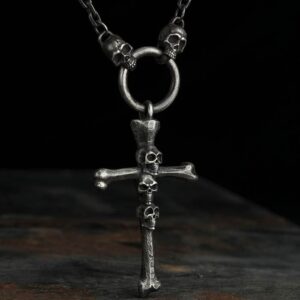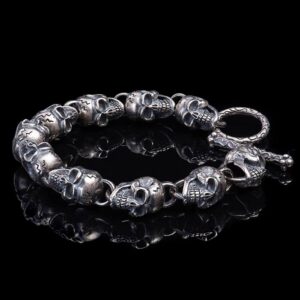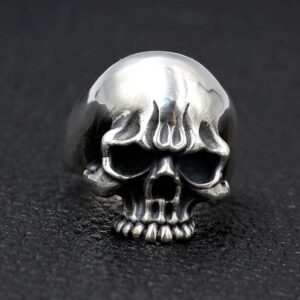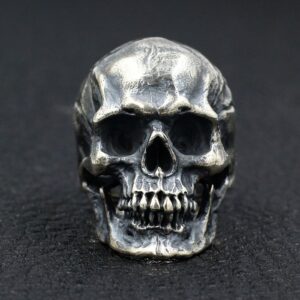Somebody say that within everyone resides both an angel and a demon. If the dazzling and splendid Baroque jewelry is considered the wings of an angel, then the mysterious and dark Gothic jewelry can be seen as a kiss from the devil. What people long for is not just the bright sun in the sky, but also the alluring and intriguing depths of darkness. Gothic jewelry, unintentionally, has become a form of rebellion against the conventional embrace of life.
Gothic originally referred to the Goths, a Germanic tribe in Western Europe. The Gothic style is characterized by its complexity, depth, towering structures, gloominess, eeriness, mystery, and terror. It spans various artistic fields, including architecture, sculpture, painting, literature, music, fashion, and typography. Gothic art is characterized by exaggeration, asymmetry, uniqueness, delicacy, complexity, and abundant decoration, with the frequent use of vertically extended lines being a prominent feature.
Artistic styles are never born out of pure love or hatred; before understanding any art movement, one must first interpret the historical stories behind it.
The term Gothic was initially used during the Renaissance to distinguish the art style of the medieval period (5th to 15th century). It is also translated as "goth," derived from the Gothic tribes in Germany, who invaded Italy and dismantled the Roman Empire between the 3rd and 5th centuries. By the 15th century, the Renaissance ignited a revival of classical ideals, and people began to yearn for the ancient times, sparking the brilliant Renaissance movement.
During the Renaissance, due to the lingering resentment among Italians for the Gothic tribes' destruction of the Roman Empire, they referred to the artistic style of the medieval period as "gothic," meaning "barbaric." The so-called "Gothic revival" was an attempt to unearth the dark and mysterious atmosphere of the medieval era from the tomb of historical context. Therefore, Gothic art is filled with a mysterious and eerie ambiance.
The Gothic style is prominently displayed in various artistic fields. Particularly in film and television, Gothic aesthetics have become deeply ingrained. In recent years, a plethora of vampire-themed films seems to equate Gothic-style jewelry with the mysterious vampire families. The necklace worn by the female protagonist Elena in "The Vampire Diaries," used to break vampire enchantments, is a dark silver accessory adorned with blood-red gems, showcasing the mysterious and irresistible allure of Gothic style.
This is not a baseless association. In the Romantic movement of the 19th century, the dark and mysterious vampire aesthetic became fashionable among noble young women. Gothic-style clothing with an ancient mysterious quality perfectly met the need for self-expression. The dark and Gothic-style clothing gradually spread and influenced the makeup of women at that time, often centered around black and white.
Early Gothic fashion was popular only among a niche group, criticized by mainstream society as decadent, unconventional, and lacking aesthetic appeal. With the passage of time, Gothic fashion began to merge with other elements, creating more diverse and rich images, gradually gaining acceptance among a wider audience and even becoming an indispensable element in fashion weeks.
As a materialized entity embodying spiritual and cultural totems, jewelry accessories naturally reflect one's inner state. The design of Gothic jewelry is mainly applied to accessories such as collars, necklaces, rings, and bracelets, using color and exaggerated shapes to express its mystery and darkness.
The colors of Gothic-style jewelry typically include black or other dark hues, with patterns often featuring religious symbols, among which the cross is the most representative. The materials used are often silver or other metallic textures, combined with elements such as rivets, chains, fishnet patterns, and feathers that evoke associations with witchcraft.
Although Gothic-style jewelry comes in complex and varied styles, several classic elements have become symbols of Gothic jewelry. Firstly, the cross, as a classic representation of religious symbols, carries complex meanings of death, redemption, punishment, and rebirth in Gothic culture. The cross element is present in various styles, with Gothic crosses often using their own dark hues as the main color tone.
Feathers, especially black ones, evoke images of crows circling over castles, accompanied by their mournful cries, making feathers a representative element of Gothic style. The soft nature of feathers also highlights the gentle beauty of femininity. Bats, bearing a striking resemblance to feathers, are also incorporated, especially favored by many modern jewelry designers as part of their artistic inspiration.
Of course, elements with a "sinister, eerie, mysterious, and terrifying" quality, such as skulls, are essential, adding a strong visual impact. In addition to skulls, many other asymmetrical or mysterious totemic elements are used, seemingly narrating the inviolability of life and death.
The so-called "dark and mysterious" Gothic style, from being denied to being embraced by a niche group, and then becoming a recognized mainstream jewelry art form, reflects the ever-changing and fickle preferences of people. What remains unchanged is the powerful and irresistible charm of Gothic jewelry. From being unrecognized to leading fashion, the romantic spirit of Gothic culture has given cultural consciousness more possibilities and brought more surprises and possibilities to self-expression.
-
All Skull Links Bracelet
$225.00 – $242.00 Select options This product has multiple variants. The options may be chosen on the product page -
Sterling Silver Angry Flames Skull Ring
$102.00 Select options This product has multiple variants. The options may be chosen on the product page -
Sterling Silver Big Tough Men Biker Skull Ring
$105.00 Select options This product has multiple variants. The options may be chosen on the product page




